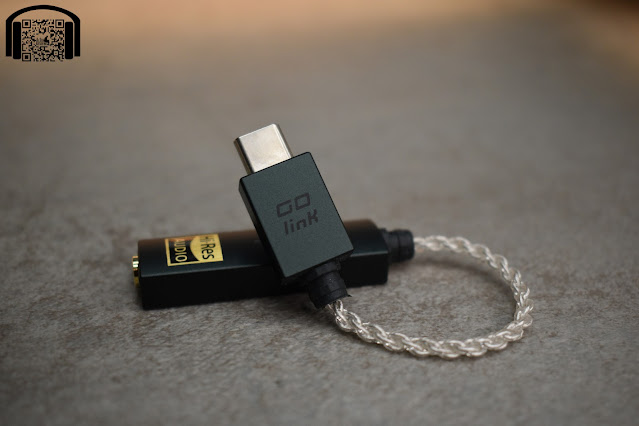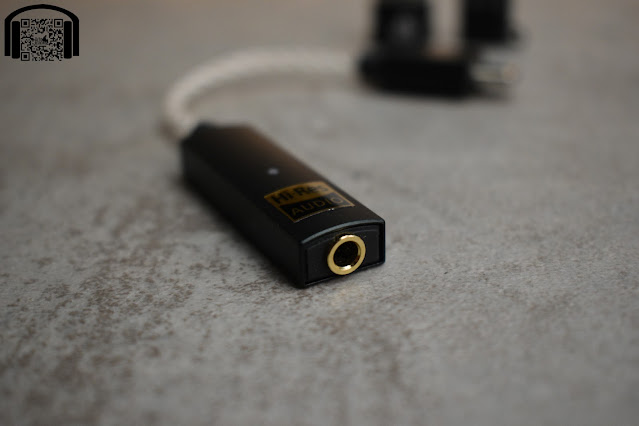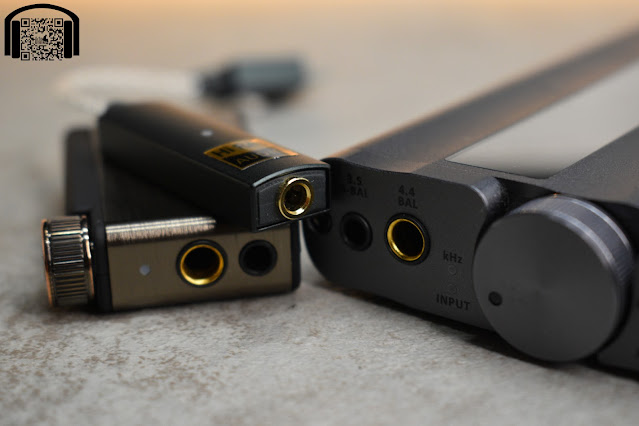- Get link
- X
- Other Apps
English | Español
TLDR version on YouTube: TDLR - iFi Audio Go Link
The iFi Go Link has been sent to me by iFi directly for me to try it out and share my opinions in this review. iFi have not made any requests or comments and I will, as always, do my best to be as impartial and honest as possible.
The official page for the Go Link can be found here: https://ifi-audio.com/products/go-link/
(As with all links that I share, this is a non-affiliate link).
To avoid being repetetive in my reviews, you can find all the info about how I create the reviews, equipment used, how I receive the products and how to interpret my reviews by visiting: About my reviews
Intro…
A while back I had the chance to review the iFi Go Bar, a (not so) little dongle by the brand that is a great device but comes at a premium price point. I had nothing but praise for the Go Bar but I concluded by saying that the price was just too high for my personal budget for a dongle device (especially as I already have the iFi Gryphon as my main “trans”portable listening device).
But recently iFi have been releasing some very interesting things at the other end of the budget scale, such as the iFi UNO, providing some very good musical performance at very reasonable price points. Now it is the turn of their latest dongle, the Go Link, which is priced at 59€ and is obviously an option that will be much easier on the pockets for many more people.
I am not going to compare the Go Link with the Go Bar, on one hand because they are at completely different price points and on the other, because I don’t have the Go Bar on hand to do a direct comparison.
One final thing before getting into the review. I am using firmware v1.80, so some things may differ on other versions of firmware.
Now, let’s get on with the review of the Go Link…
Presentation…
In a small and simple box, following the usual “no frills but well packed” style of iFi, we receive the Go Link along with a USB-C to USB-A adaptor, a Lightning to USB-C adaptor, a simple user start guide, some more documentation (warranty related) and an iFi sticker.
This is actually far more than is usually included with the purchase of a simple dongle dac, so congrats to iFi for including this at a price point that is not the cheapest on the market but is still lower than much of the competition that include nothing.
Build and aesthetics…
The Go Link is not going to win any prizes for its build quality and aesthetics, however, it is far from being poor. The dongle itself is an elongated rectangle with just a slight curve to the top part, stopping it from being a simple little box but only just.
On the top of the dongle there is a single LED which changes colour to show the format of the track being played. At one end of the device we have a single 3.5mm unbalanced headphone output, and at the other end we have a fixed cable that runs to the USB-C connector. While it would have been great to see a detachable cable, I understand that costs need to be kept down so I am not going to complain about it.
However, I will say that my two gripes are that the USB-C connector is overly large and square (making it a difficult fit with some phone/tablet covers) and that the plastic (or hard rubber) glands that serve as stress relief for the cable are not the most elegant of solutions. The second of these is a comment, not really a complaint, but the oversized USB-C connector may prove to be an issue for some people. The connector also does not match the style of either of the included adaptors, which doesn’t hinder functionality but does look a little strange. In my opinion, I would have preferred a USB connector that matches the format of the Lightning adapter, but again, not really a major complaint.
Functionality…
There really isn’t much to explain here, you plug the USB into your device (with or without an included adapter) and your headphones into the 3.5mm, e voilá.
The only issue I have experienced with the Go Link is something that I also experienced with the Questyle M15. When using the dongle connected to a PC and using Tidal in exclusive mode, a track change will sometimes change the volume level to full. This is on a Windows 10 PC and happens sporadically on multiple laptops I use (I can’t say if this happens on other machines/OS).
As the Go Link is a very simple device, without any of the typical iFi boosts or any controls, I don’t think there is really anything else to say under functionality other than it works.
Sound…
When I first started listening to iFi products, I discovered that iFi “house sound” that is spoken about so much, where things just have that smooth and slightly warm touch to them, without becoming boring or seeming to lose any details. The main consensus was that the “house sound” was due to the fact that iFi uses Burr Brown chips in their design. There was nothing, at the time, to lead me to think any different.
However, over the past year or so, we have seen multiple other choices as far as DAC chips used in iFi products and they have somehow managed to keep that “house sound” that I have come to expect from them. The last product I tried from them was the UNO, which uses an ESS Sabre DAC chip and, once again, they managed to retain that iFi flavour. The Go Link again opts for an ESS Sabre chip and guess what… they managed to once again give it that iFi flavour. This proves more and more that, while the DACchip is important, the integration and design of the device is what gives us that final sound.
I am not saying that the Go Link sounds identical to other iFi devices, moving from the Go Link to the Gryphon or the Go Blu does certainly show differences, but it is certainly identifiable as an iFi sound.
I have been trying the Go Link with multiple sets of headphones and IEMs, which it doesn’t seem to have had any issue driving, and while I feel it does leave something to be desired when trying to power some of my Hifiman planars, I have to say that I have really enjoyed it with almost anything I have tried.
It is not the most powerful of dongles but I did find that it drives things like the HD6XX to levels above what I would need in terms of decibels. I wouldn’t pick the Go Link personally to power the HD6XX as I have grown to like these headphones via a tube amp, but it is certainly not a combination that I tried and thought “wow, these sound bad”. I actually enjoyed them for a few hours while doing other things.
With planars, as I just mentioned, I did find that the dongle struggled with the fast moving bass lines and could overall sound a little muffled with some harsh peaks appearing on occasions. With the more easy to drive planars like the Ananda (OG), the dongle did much better and was decent for the majority of music I listen to, yet, with tracks that were overly busy and fast in the lower ranges, I again found them to be seeming to struggle to keep up. Though, let’s be fair here, I don’t think the Go Link is aimed at driving things like Hifiman planar headphones.
Going with something a little more realistic but sticking with headphones, I found the dongle had no issues driving things like the DT1990 Pro, the Custom Studio, the Thieaudio Ghost, just to name a few. With things like the Koss KPH40, it does an excellent job and I was happy to spend hours listening to that combination.
Moving over to IEMs, which are more what I think about when choosing a dongle, I didn’t find it to have any problem at all with anything I threw at it. From budget DD offerings like the Cadenza, planar options like the S12 or even things higher up on the price list such as the IE600, I found it did a great job. I also enjoyed the pairing with the Dunu Talos and the Vulkan, two sets that I find benefit from a little of that iFi “warmth and smoothness”.
So, as a recap, the iFi Go Link performs well in the sound category with a lot things, in fact, most of what I have on hand (or at least what I have tested from what I have on hand), except for more demanding planar options. But this really doesn’t explain much about how it really is sound wise, so I will do a few quick comparisons to see if it helps place the Go Link amongst what I have on hand.
Comparisons…
For the comparisons I decided to focus on using one set of IEMs, the Hifiman Svanar. Yes, it is a bit crazy to pick a set of 2000€ IEMs to test a 60€ dongle but I find that the Svanar is actually the set of IEMs that is most revealing of source changes, at least from the IEM collection that I have on hand.
Also, please remember that reviewers (including myself) tend to explain differences in a way that is more exaggerated than reality. When we say that something is much warmer, or far more detailed, or much more clinical, you may find that the difference is hardly noticeable (or not noticeable at all) in your own experience. This is not in an attempt to be misleading, it is more of an attempt to try to explain the differences that I hear, or at least think I hear (sometimes it is just my brain filling in blanks and making me expect to hear it, therefore I do 😉 )
Apple Dongle
Let’s start off with a classic, the Apple Dongle. Coming in at less that 10€, I think anyone who has read anything about IEMs will have come across it and, honestly, if you don’t own one, buy one, I own at least 4 or 5. There are two versions of the Apple dongle, the US (or non-EU) version and the EU version. The difference is that the EU version is limited on power and yes, it is noticeable (especially when using it with things other than IEMs).
I find that the Apple Dongle is a very neutral, no frills, dac/amp that drives most things well. I don’t find it to really add any of its own flavour to anything and while it is not really exciting, it is not boring either, it is just… well, the Apple Dongle.
In comparison I find the Go Link to have a sound that is slightly smoother, without giving the sensation of any loss of detail or that anything has really changed much. It is a more relaxed and pleasant listen in my opinion. With the Svanar, I find that the Go Link vs the Apple Dongle is sort of like the Atom vs the Asgard 3, one is clean and no frills whereas the other is still clean yet has a bit of a roundness to the sound.
There is no doubt that the Apple Dongle works well but for pure music enjoyment, I prefer the Go Link.
Questyle M15
This is the other extreme. Where the iFi is 5 times the price of the Apple, the Questyle is 5 times the price of the iFi. This is not a fair comparison but the M15 is the dongle DAC that I use most and the Go Link actually stands up to the fight remarkably well. I have only compared the SE out of the M15 as the Go Link is SE only.
The M15 does a better job of driving more demanding headphones but we are focusing on the Svanar here, so I will limit myself to that. In the case of the M15, the Svanar gives me more sensation of detail and performance than with the Go Link. I find that smaller background details are more present and that they seem to have more life to them.
However, I would say that the Go Link seems to create a slightly bigger sensation of space, even if the background details in that space are not quite as focused. The Go Link again gives a smoother presentation and while the M15 would be my choice for focusing on the details of the music, I find that the Go Link can be more of an enjoyable BGM listen, taking away some of the focus and just giving you a well presented overall picture.
Go Blu
Moving on to something iFi, the Go Blu is my usual choice for portable listening on the move. I actually find that I use the SE output of the Go Blu more than the balanced as it is a bit warmer and more “rounded” to my ears, making for a more relaxed general listen than an actual dedicated listening session.
I would actually say that the listening experience of the Go Link is most similar to the SE output of the Go Blu. I find that the overall presentation is very similar and that my enjoyment is also on a par. Yes, the Go Blu obviously has more functions and is a completely different device (at a higher price point) but for general listening, when I don’t need any of those additional functions, I find that the Go Link is on a par for my personal enjoyment.
Gryphon
As my last comparison, my most used “trans”portable device, also from iFi. The Gryphon is in a completely different league as far as functionality, build, price and, well, everything. However, comparing the SE output of the Gryphon (without making use of any of those other things) to the Go Link, there are noticeable differences but not necessarily in completely different leagues.
The Gryphon is obviously more powerful and it handles planars (and other difficult to drive options) better, yet in pure sound quality when powering the Svanar, it is not night and day. Yes, I prefer the Gryphon, it gives a much better representation of detail, space and overall music presentation but just sitting back and listening without dissecting what is going on, the Go Link is surprisingly close in terms of enjoyability.
No, I am not saying that the Go Link is rivaling the Gryphon is SE performance, what I am saying is that, when I sit an listen to the Go Link, I find myself enjoying the music and not really thinking “I need that extra xx% of detail that the Gryphon gives me”. There is a very similar flavour to the music, a relaxed and calm presentation that, on an enjoyment level, places it far too close to a device that is 10 times the price.
Conclusion…
Well this has turned into a longer review than I expected. I don’t know why that is always the case with sources, I seem to ramble on and still miss things 😊
As far as the iFi Go Link, I have to say that it is an impressive little dongle for the price. It is not balanced and it is not the most powerful dongle on the market but it is plenty for a normal use case. It is not the cheapest dongle on the market but it is certainly a long way from the expensive options and the performance may not be the most detailed you will find (when comparing to other higher end alternatives) but it more than makes up for it with the pleasurable listening experience that it provides.
I remember reviewing one of the budget desktop options from iFi and saying that it was now possible to get a taste of the iFi sound at a reasonable price. Then, along came the Air which made it even more affordable. Then the UNO, which dropped the price of the iFi flavour to an even more attainable price. Now we can get a taste of the iFi house sound with just our phones and a 59€ dongle.








